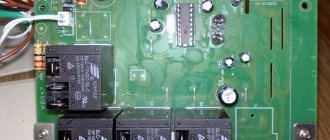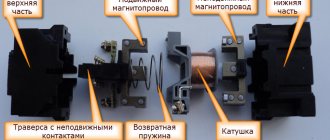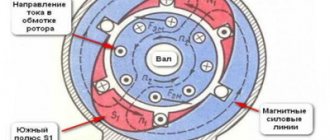More and more electrical appliances in our everyday life contain complex electronics that are designed for a certain power range of 220 Volts. Unfortunately, the power in our outlets is not always stable, which you can notice by dim or brightly flashing light bulbs. By using a stabilizer you will normalize the voltage and possibly avoid costly repairs to your TVs, refrigerators and other complex and expensive equipment. In the article we will tell you which 220 V voltage stabilizer to choose for specific conditions: for a home, for a dacha, for an apartment, or specifically for a gas boiler.
Features of single-phase voltage stabilizers
How do they work?
Any modern voltage stabilizer is a fairly complex high-tech device with an automatic operating mode that does not require any user intervention.
Single-phase stabilizers with transformer conversion (relay, thyristor, triac) have a general algorithm for constructing load protection from poor-quality voltage. The input network voltage is supplied to the electronic control board, where it is measured and compared with the nominal value. If an unacceptable deviation occurs, the control unit sends a signal to the actuator, which adjusts the voltage.
Inverter-type stabilizers work fundamentally differently. The voltage conversion in them takes place in two stages: first, the rectifier converts the unstable alternating voltage into direct voltage, and then the inverter again creates from it an alternating voltage of the required value with a stable sine wave.
Readers familiar with the operating principle of uninterruptible power supplies (UPS) of the online topology may note the similarity of their operation with inverter stabilizers: constant double voltage conversion, completely eliminating stabilization delay.
Where are they used?
The products are designed for use in an electrical network with one supply phase, and the network can be either problematic (for example, with chronic voltage deviations from the norm) or normal (that is, without characteristic fluctuations and distortions).
Important!
Any network can turn from normal to problematic at one moment. All it takes is a gust of wind that breaks a wire or an electrician’s mistake, and the voltage that has not caused any complaints for years suddenly begins to “strange”, rising or falling by tens or even hundreds of volts.
Single-phase stabilizers are used both in everyday life (apartments, private houses, cottages) and in commercial/industrial facilities (shops, offices, enterprises). The main thing is that at the point where the device is connected to the network, there is a voltage with the appropriate phase and value at which the stabilizer is able to function.
There are three scenarios for using a single-phase stabilizer:
- locally, for protection with a single load;
- locally, to protect several electrical appliances;
- backbone to the entire network of a premises or building, for example, a country house.
In the latter case, centralized protection is provided for all electrical appliances operating in the network at once, the stabilizer itself is connected through the distribution panel between the input circuit breaker and the final loads (strictly after the electricity meter).
Note!
Any work with an electrical panel, including those related to the installation of a centralized stabilizer, requires the person performing it to have basic electrical knowledge, as well as electrical installation skills.
Note!
It is possible to ensure protection of the entire network using one single-phase stabilizer only under single-phase input conditions.
What load can they handle?
In theory - with any one that is suitable in terms of power and required voltage (it must correspond to the output voltage of the stabilizer). In practice, unfortunately, not all stabilizers can work effectively with modern household appliances and electronics, not to mention equipment that is more demanding in terms of power supply quality.
How do they connect?
It is known that any single-phase electrical circuit consists of only two working conductors (phase L and zero N) and one protective grounding (PE). Therefore, to connect a single-phase stabilizer (if we are talking about a powerful device), it is enough to connect these conductors of the supply network to its input terminals on the case, and connect the protected electrical device to the output terminals, of course, not forgetting about the grounding conductor.
Connecting low-power stabilizers to the network is an even simpler process that does not require any special knowledge and is performed by simply plugging the plug into the outlet. A similar plug connection is used to connect the protected electrical appliance to a socket located on the stabilizer panel.
Can they be used in conditions of three-phase network input?
Obviously, all single-phase stabilizers are designed to protect single-phase electrical appliances. However, this does not mean that they can work only in single-phase networks. There are many examples of organizing the protection of electrical appliances in three-phase networks using single-phase stabilizers. Such a connection is possible, but only with a single-phase load and only when connected to one of the phases and the neutral. In this case, the devices can operate both as main ones (correction and stabilization of the voltage of the entire home network) and local (protecting only some electrical appliances).
Note!
If there are three supply phases, to obtain centralized main protection, you will have to resort to installing three single-phase devices, one for each phase. It will be possible to get by with one device if you use a three-phase device or a “3 in 1” combined device.
The only limitation on the use of single-phase stabilizers in a three-phase network is the presence of at least one three-phase equipment (for example, an electric stove). To properly protect it, only a three-phase stabilizer should be used.
All types of valid and invalid connections are shown in the figures below.
Note!
It is prohibited to connect a single-phase stabilizer simultaneously to two phases of a three-phase input!
Note!
It is necessary to connect single-phase consumers to a three-phase network evenly, that is, with an equal distribution of loads across all supply lines (as much as possible). A violation of the load balance can provoke a phase imbalance - an emergency situation that can cause breakdown of devices connected to the electrical network.
Detailed Assembly Instructions
The circuit being considered for self-production is rather a hybrid option, since it involves the use of a power transformer in conjunction with electronics. The transformer in this case is used from among those that were installed in televisions of older models.
This is roughly the kind of power transformer you will need to make a homemade stabilizer design. However, the selection of other options or do-it-yourself winding cannot be ruled out.
True, TV receivers, as a rule, installed TS-180 transformers, while the stabilizer requires at least a TS-320 to provide an output load of up to 2 kW.
Step #1 - making the stabilizer body
To make the device body, any suitable box based on an insulating material - plastic, textolite, etc. is suitable. The main criterion is sufficient space for placing a power transformer, electronic board and other components.
It is also possible to make the body from fiberglass sheets by fastening individual sheets using corners or in another way.
It is permissible to select a housing from any electronics that is suitable for placing all the working components of a homemade stabilizer circuit. You can also assemble the case yourself, for example, from fiberglass sheets
The stabilizer box must be equipped with grooves for installing a switch, input and output interfaces, as well as other accessories provided by the circuit as control or switching elements.
Under the manufactured case, you need a base plate on which the electronic board will “lie” and the transformer will be fixed. The plate can be made of aluminum, but insulators should be provided for mounting the electronic board.
Step #2 - making a printed circuit board
Here you will need to initially design a layout for the placement and connection of all electronic parts according to the circuit diagram, except for the transformer. Then a sheet of foil PCB is marked along the layout and the created trace is drawn (printed) on the side of the foil.
Next, the board is etched using an appropriate solution (electronics engineers should be familiar with the method of etching boards).
You can make a printed circuit board for a stabilizer using quite affordable methods at home. To do this, you need to prepare a stencil and a set of tools for etching on foil PCB
The printed copy of the wiring obtained in this way is cleaned, tinned and all the radio components of the circuit are installed, followed by soldering. This is how the electronic board of a powerful voltage stabilizer is manufactured.
In principle, you can use third-party PCB etching services. This service is quite affordable, and the quality of the “signet” is significantly higher than in the home version.
Step #3 - assembling the voltage stabilizer
A board equipped with radio components is prepared for external wiring. In particular, external communication lines (conductors) with other elements - a transformer, switch, interfaces, etc. are output from the board.
A transformer is installed on the base plate of the housing, the electronic circuit board is connected to the transformer, and the board is secured to the insulators.
An example of a homemade relay-type voltage stabilizer, made at home, placed in a housing from a deteriorating industrial measuring device
All that remains is to connect the external elements mounted on the case to the circuit, install the key transistor on the radiator, after which the assembled electronic structure is covered with the case. The voltage stabilizer is ready. You can start setting up with further testing.
So how does the single-phase type of stabilizers differ from other types?
The following answer can be given to the question posed in the title of this article: single-phase stabilizers differ in that they have a single-phase input and the same output and, accordingly, operate from one supply phase and exclusively with a single-phase load (three-phase stabilizers, in turn, operate from three phases, and both three-phase and single-phase loads can be powered from them).
Note!
There are single-phase stabilizers of the combined type “3 in 1” (three-phase input – single-phase output). Such products allow you to connect powerful single-phase consumers to a three-phase network without the risk of phase imbalance.
Rectifier device
Not all equipment can operate on AC power. To connect them to the network, you have to use voltage stabilizer rectifiers. They are designed to generate DC current in the load. The basis of such a device is a circuit containing a diode or valve, which can be either controlled or uncontrolled. Depending on the elements used, the following types are distinguished:
- Mechanical;
- Vacuum;
- Electronic.
Their main purpose is to convert current. However, most models create ripples, which are smoothed by filters.
Are all single-phase stabilizers the same?
No, the devices differ significantly from each other. First of all, the output power, which indicates the maximum energy consumption of the load permissible for connecting, and the type on which the efficiency of the device for its main purpose depends (in fact, the stability and quality of the output voltage).
In addition, other equally important characteristics may vary from stabilizer to stabilizer; let’s summarize them in a general table.
| Characteristic | Physical meaning | Practical significance |
| Rated output voltage | The value to which the stabilizer should reduce the actual value of the voltage received from the network | This is the voltage that will power the load. |
| Response speed or performance | The period of time spent by the stabilizer to neutralize the network surge, or, in other words, to bring the deviated network voltage to the nominal value | As performance increases, the likelihood of negative impact of network surges on the connected load decreases |
| Input voltage range | Limit network values (lowest and highest) that the stabilizer is capable of bringing to the nominal value | These are the limits of network fluctuations permissible for the device. The wider this range, the worse the conditions the stabilizer will be able to operate. |
| Accuracy | Maximum possible stabilization error | It is measured as a percentage and reflects the discrepancy between the nominal voltage and the voltage actually supplied to the output of the stabilizer. With increasing accuracy, the range of products allowed for connection expands |
| Output waveform | Correspondence of the output voltage to the graph of an ideal sinusoid | Some devices require a sinusoidal supply voltage to function correctly, so the inability of the stabilizer to consistently output such voltage may limit its scope of application. |
| Dimensions and design | The size of the device in three planes and the shape of its body | Determine the installation method of the device and indicate the amount of space it requires |
Note!
In addition to all the characteristics discussed above, single-phase stabilizers may also differ in the level of emergency protection, as well as in the means of monitoring and indication.
SUNTEK PR 500 VA SK1.1 PR0500 – for four consumers
A device for leveling voltage surges. Equipped with four output sockets for individual consumers. Equipped with light indication for visual monitoring of equipment operation. Additional display of information on a digital display.
The device is equipped with a durable plastic body and a practical carrying handle. The design of the stabilizer allows operation at positive and negative temperatures; no additional maintenance is required.
Pros:
- Reasonable price, optimal power to serve four consumers.
- Nice design, comfortable handle, no maintenance required, just wipe off the dust.
- Simple and intuitive operating interface.
Minuses:
- Not noted.
How to choose a single-phase stabilizer?
Proceed according to the following algorithm:
- Decide on the scenario for using the device (one load, a group of loads or the entire network at once).
- Find out the amplitude of characteristic voltage drops at the site of the planned operation (it can be found out by making control measurements of network parameters at different times of the day).
- Calculate the maximum load power (Pmax load).
- Allow a power reserve of 30%: Pmax loadx 1.3 = Pneobx - this is exactly how many watts the stabilizer should produce in order to be guaranteed to power the intended load.
- Check the Pneobx value with the power range of stabilizers on the market. Models with the closest (on the larger side) output power value are suitable.
- From stabilizers suitable for power – Rout.stab ˃ Rneobh – weed out those that have:
To do this, sum up the power consumption (Rinput) of the devices planned for connection: Pmax load = Rintr 1+ Rintr 2+ ... + Rintr N.
Please note!
If the power consumption of any device changes during operation (for example, due to inrush currents), then the largest possible value should be used in the calculation.
Note!
When choosing a stabilizer for centralized network protection, it is not necessary to sum up the power of all consumers present in it. It is enough to multiply the rated current of the input circuit breaker installed in the electrical panel by the value of the rated voltage for the network: Pmax load = Inom x 220 (or 230).
Note!
It is not recommended to consider models with an output power that is closest to Pneobx on the smaller side, since their choice neutralizes the power reserve previously laid down. In the worst case, there may be a critical discrepancy between the power of the stabilizer and the load: Pout.stabil < Pmax load - in such a situation the device will not be able to operate due to constant overload!
- the input voltage range is narrower than the amplitude of the most frequent network oscillations;
- the error is greater than the input voltage deviation permissible for the connected equipment;
- The dimensions do not correspond to the installation location (the product cannot be placed according to its operational position).
- Select a specific stabilizer model from the remaining ones based on financial capabilities and the desired level of protection (the highest for inverter stabilizers).
Note!
Make sure that the disadvantages inherent in the stabilizer of the chosen type, and they are present in almost all devices, will not affect the functioning of the load.
Resanta ASN 1000/1-C – protection of expensive electronics
Single-phase input voltage stabilization transformer. The response time does not exceed 0.007 seconds. A microprocessor control system has been introduced. An effective overheating protection mechanism is used.
Automatic shutdown has been introduced when the peak values of the electrical network are exceeded; a decrease in load causes the stabilizer to turn on. The output data is reflected on a digital display. Filters are provided to smooth or cut off frequency interference.
Pros:
- Cost effective, reliably protects household electrical appliances.
- Copes well with its main responsibilities, the quality is at the level.
- Neat appearance, handle for transportation.
Minuses:
- It produces unpleasant odors for several weeks.
- The readings on the display do not correspond to the actual ones.
Selecting a single-phase stabilizer. Practical examples
Example 1: Unit Load Protection
Single-phase network with a nominal value of 220 V, fluctuations within 130-260 V. Single load with a power consumption of 120 W and a permissible input deviation of 6%.
The required power of the stabilizer is: 120 x 1.3 = 156 W - from which it follows that in this case a device with the following characteristics is suitable: output power of at least 156 W, accuracy of 5% or better, input voltage range wider than 130-260 V .
Example 2: Protecting Multiple Loads
The network is similar to example 1, but there are already three loads:
| No. Load | Power consumption, W | Permissible input deviation, % |
| 1. | 120 | 6 |
| 2. | 80 | 15 |
| 3. | 780 | 10 |
Let's find the total power consumption: 120 + 80 + 780 = 980 W. Let's set aside a reserve: 980 x 1.3 = 1274 W.
When there are multiple loads, the accuracy of the stabilizer should be selected based on the smallest permissible deviation. This means that in our case we will need a device with an accuracy of at least 4%, an output power of at least 1274 W and a range wider than 130-260 V.
Example 3. Centralized protection of all consumers in a single-phase network
The same network, but now we need to organize centralized protection for all consumers. The rating of the input circuit breaker is 32 A.
The possible load power will be: 32 x 220 = 7040 W, it will require from the stabilizer (taking into account the reserve): 7040 x 1.3 = 9152 W.
When connected centrally, equipment with different requirements for the quality of the supply voltage may be included in the network protected by the stabilizer, so we recommend choosing a product with the maximum accuracy parameter.
As a result, in this example the stabilizer needs: an output power of at least 9152 W, maximum accuracy (1-3%) and an input voltage range similar to examples 1 and 2.
Example 4. Consumer protection in a three-phase network
Three-phase network with a rating of 400 V (230 V per phase) and phase voltage fluctuations of 140-260 V. The rating of the input three-pole circuit breaker is 16 A. There are only single-phase consumers, which allows organizing protection based on appropriate stabilizers.
The permissible load per phase: 230 x 16 = 3680 W. Therefore, a suitable stabilizer must produce at least 4784 W (3680 x 1.3 = 4784), have maximum accuracy (1-3%) and a range wider than 140-260 V.
It is possible to install either one product (for the priority load) or three (for each phase).
Example 5. Protection of a load whose power consumption is greater than the power of one phase of a three-phase network
Everything is the same as in the previous example, but there is a single-phase product or an indivisible group of single-phase products with a power of 7000 W. Such a load cannot be powered from a separate phase of the network in question; the way out of the situation would be to use a stabilizer with a “3 in 1” configuration, capable of dividing the power consumption equally into all phases.
If the product operates only with the specified load, then its required power will be: 7000 x 1.3 = 9100 W.
If the task is to protect the entire network, then we will calculate the output rating of the stabilizer using a simplified formula for determining power in a three-phase network: 400 x √3 x 16 = 11085 W. Let's take into account the margin and get the final results: 11085 x 1.3 = 14,410 W.
The requirements for accuracy and range (in this case, phase voltage) will be similar to example 4.
Note!
Using a stabilizer with a “3 in 1” configuration allows you to power a single-phase consumer with an energy consumption greater than the power of an individual phase of this network from a three-phase network.
Types and their characteristics
The most popular types of devices:
Step rectifiers
These are the most common AC voltage devices. It is convenient because such a stabilizer has some of the best characteristics. Also, the pricing policy is quite democratic. The equalizer operates using special tap keys with different AC coefficients.
Ferroresonant devices
This transformer is considered the first, it is no longer as modern as the others. Due to its shortcomings, the transformer is not popular. It is too noisy and large in size. Also, high sensitivity to voltage changes prevents the device from working effectively.
Electromechanical current transformers
They work with the help of a motor that controls the slider. It is very high-precision, adjustable using special coils. Has a wide stabilization range. But there are significant disadvantages of such a rectifier. It wears out very quickly, the mechanism only works after one year. No sound insulation, very loud.
Transformerless devices
One of the newest types of transformers. It has a number of positive aspects, which significantly distinguishes it from all available models. First of all, it is an extended input voltage spectrum, high power, lightweight, small-sized. The only significant drawback of such a transformer is its too high price. The average consumer will not always be able to afford it.
Also, they all differ in phases:
- Single-phase.
- Three-phase.
Considering single-phase transformers in detail, several features can be identified. It is needed when using household appliances with a mains voltage of 220 volts. They can solve many problems regarding the electrical supply of the home.
Three-phase rectifiers are recommended for enterprises with 3-phase output. This happens when the load on the electrical network is very large and its distribution is several phases.
FAQ
How to calculate the power of the stabilizer I need?
Each electrical appliance must have a passport indicating its operating characteristics. If it is lost, you can always find it on the Internet. Add up all the power - you get an approximate value.
You can’t buy an end-to-end stabilizer - you’ll end up with almost the same thing that old TPs provide. Take a power reserve of 30-50% so that you can use other tools.
Speaking of tools, don't forget to consider the powerful tools you plan to use. The tool has large starting currents, a factor of 2-3. Therefore, if you plan to use powerful machines, feel free to take a stabilizer twice as powerful as the consumer one.
What is the difference between an IPB and a stabilizer?
The stabilizer works as long as voltage is present. An uninterruptible power supply is a battery that needs a network to recharge. They do not produce a pure sine wave, therefore they are inferior to stabilizers in the role of “protectors” of the house.
UPS - uninterruptible power supplies - are needed for emergency power supply. For example, gas boilers in case of a power outage. The UPS stores power in low-voltage batteries, and during a power outage, it supplies current with the required voltage. Not all UPSs produce a pure sine wave.
The stabilizer brings the mains electricity parameters back to normal and does not store energy.
Why is it needed?
Primarily to protect delicate office and household appliances. The worse the quality of electricity, the shorter the lifespan of your reliable refrigerator and trusty TV.
In Russia, GOST 32144-2013 dated 07/01/14 is in force for the quality of electricity, according to which:
- the voltage should not go beyond 220V (380V) +/- 10%;
- frequency 50 +/- 0.4 Hz;
- flicker dose does not exceed 1.0;
- there should be no odd harmonics, negative and zero sequence components and other high matters











